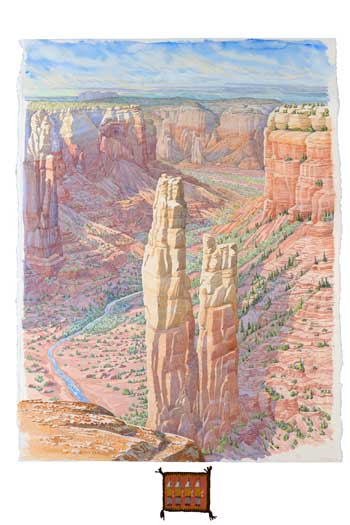
Tony Foster - Sacred Places, Watercolor Diaries from the American Southwest
June 16, 2013 – October 13, 2013

Spider Rock from Spider Rock Overlook, © 2012 Tony Foster, Watercolor on paper, 36″ x 28″, Photograph by Trevor Burrows PhotographyAn exhibit of paintings created by English artist Tony Foster during three year journey to explore sites in the American Southwest that have sacred associations for a broad range of cultures and faiths. Foster painted in locations that were sacred to ancient peoples, and others that are sacred to contemporary Native Americans and a broad range of cultures, faiths, and belief systems.
“All societies need to express their reverence for extraordinary places,” said Foster. “Tribal societies express it through their religious practices and ceremonies. Our own, more secular society, expresses it by designating national and state parks, national forests and monuments, thus rendering them sacrosanct. It could be argued that the environmental movement is the secular means by which we express our need to honor the earth.”
The Sacred Places journey led Foster to create a body of 33 works of varying sizes (some as large as three by six feet). The exhibition also includes a series of eight paintings which document a trip down the San Juan River in southern Utah and depict a riparian environment, significant to all of the natural and social sciences.
For the MNA exhibition, Fine Arts Curator Alan Petersen selected a number of objects from MNA’s collections with their origins near the locations of Foster’s paintings. Seeking to create a philosophical dialogue with viewers, these objects enhance the story of the contemporary artist, and those artists and crafts people for whom these places are, or were, sacred.
Foster has explored Earth’s wilderness regions with his watercolors for more than 25 year. He travels slowly and deliberately, often backpacking on foot, creating his paintings onsite and adding finishing touches at his studio in Cornwall, England.
“Tony Foster’s paintings are a celebration of the beauty of the natural world, and the personal and visual freedom found in remote locations,” said Petersen. “His paintings are far more than simply depictions of a specific location. Foster’s watercolors combine the painted image with small natural or man-made objects that tell other aspects of the story of his subject. Often his works of art include an entry from his journal and a section of a topographical map, depicting the location and giving the painting a clear geographical context.”
Museum Director Dr. Robert Breunig adds, “Foster’s works of art are visual poems that give form to the feelings and thoughts that the beauty of the Colorado Plateau inspire. They clearly illustrate the geographical and geological diversity that marks a journey in any direction across the Plateau Province, as John Wesley Powell called it. Tony Foster’s paintings of sacred sites on the Colorado Plateau speak to the richness of the human experience here, the beauty and complexity of the natural world, and the ways in which humanity has given meaning to those places.”
The exhibit is accompanied by a catalog containing reproductions of all the paintings and materials, and includes contributions by curators, philosophers, and ethnologists.
